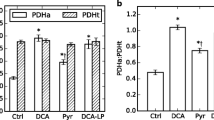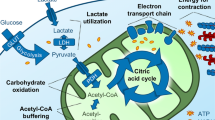Abstract
In the present study the hemodynamic and metabolic effects of pyruvate (5 mM), added as cosubstrate to glucose (11 mM) perfused, transiently ischemic, isolated working rat hearts, were evaluated. During 2 h of normoxic perfusion pyruvate improved functional stability, prevented depletion of glycogen and triacylglycerol stores, and increased non-esterified fatty acid (NEFA) levels, even at relatively high workloads. The elevated NEFA levels are in line with the notion that pyruvate competes with endogenously produced fatty acids for oxidative energy production. After 45 min of global ischemia pyruvate was found (a) to affect markedly the relative contribution of ATP, ADP and AMP to the total adenine nucleotide content and (b) to stimulate the degradation of glycogen and to enhance the accumulation of lactate, suggesting enhanced anaerobic ATP rroduction. After restoration of flow pyruvate reduced the incidence of fibrillation and markedly improved recovery of cardiac output at both normal and high workload. Pyruvate did neither attenuate the release of lactate dehydrogenase, a marker for cell death, nor improve the conservation of the total adenine nucleotide and ATP content of hearts reperfused for 30 min. The latter findings indicate that hemodynamic recovery during reperfusion in the presence of pyruvate is neither related to the absolute tissue content of ATP nor to a reduction of irreversible cell damage, and suggest that pyruvate exerts its advantageous hemodynamic effects rather by improving the condition of reversibly damaged cells during reperfusion.
Similar content being viewed by others
References
Bergmeyer HU, Bernt E (1974) UV-assay for lactate dehydrogenase with pyruvate and NADH. In: Bergmeyer HU (ed) Methods of enzymatic analysis, vol. 2. Verlag Chemie Weinheim, pp 574–579
Bricknell OL, Opie LH (1978) Effects of substrates on tissue metabolic changes in the isolated rat heart during underperfusion and on release of lactate dehydrogenase and arrhythmias during reperfusion. Circ Res 43:102–115
Buenger R, Haddy, FJ, Querengaesser A, Gerlach E (1975) An isolated Guinea pig heart preparation with in vivo like features. Pflügers Arch 353:317–326
Buenger R, Swindall B, Brodie D, Zdunek D, Stiegler H, Walter G (1986) Pyruvate attenuation of hypoxia damage in isolated working guinea-pig heart J Mol Cell Cardiol 18:423–438
Duvelleroy MA, Duruble M, Martin JL, Teisseire B, Droulez J, Cain M (1976) Blood-perfused working isolated rat heart. J Appl Physiol 41:603–607
Evans JA, Opie LH, Renold AE (1963) Pyruvate metabolism in the perfused rat heart. Am J Physiol 205:971–976
Goldstein RA, Klein MS, Sobel BE (1980) Detection of myocardial ischemia before infarction, based on accumulation of labeled pyruvate. J Nucl Med 21:1101–1104
Gutterman DD, Chilian WM, Eastham CL, Inou T, White CW, Marcus ML (1986) Failure of pyruvate to salvage myocardium after prolonged ischemia Am J Physiol 250:114–120
Hendriks FFA, Jonas DJ, Van der Laarse A, Huysmans HA (1983) Cardioplegic arrest in isolated blood-perfused working rat hearts. J Surg Res 35:41–49
Hewitt RL, Lolley DM, Adrouny GA, Drapanas T (1974) Protective effect of glycogen and glucose on the anoxic arrested heart. Surgery 75:1–10
Jennings RB, Hawkins HK, Lowe JE, Hill ML, Klotman S, Reimer KA (1978) Relation between high energy phosphate and lethal injury in myocardial ischemia in the dog. Am J Pathol 92:187–214
Kobayashi K, Neely JR (1979) Control of maximum rates of glycolysis in rat cardiac muscle. Circ Res 44:166–175
Kobayashi K, Neely JR (1983a) Effects of ischemia and reperfusion on pyruvate dehydrogenase activity in isolated rat hearts. J Mol Cell Cardiol 15:359–367
Kobayashi K, Neely JR (1983b) Mechanism of pyruvate dehydrogenase activition by increased cardiac work. J Mol Cell Cardiol 15:369–382
Krieger WJG, Ter Welle HF, Fiolet JWT, Janse MJ (1984) Tissue osmolality, metabolic response, and reperfusion in myocardial ischemia. Basic Res Cardial 79:562–571
Liedtke AJ, Nellis SH, Neely JR, Hughes HC (1976) Effects of treatment with pyruvate and tromethamine in experimental myocardial ischemia. Circ Res 39:378–387
Mann, GE, Zlokovic BV, Jidulevich DL (1985) Evidence for a lactate transport system in the sarcolemmal membrane of the perfused rabbit heart: kinetics of unidirectional influx, carrier specificity and effects of glucagon. Biochim Biophys Acta 819:241–248
Mochizuki S, Neely JR (1980) Energy metabolism during reperfusion following ischemia. J Physiol 76:805–812
Neely JR, Grotyohann LW (1984) Role of glycolytic products in damage to ischemic myocardium. Dissociation of adenosine triphosphate levels and recovery of function of reperfused ischemic hearts. Circ Res 55:816–824
Opie LH (1970) The glucose hypothesis. Its relation to acute myocardial ischemia. J Mol Cell Cardiol 1:107–115
Passonneau JV, Lowry OH (1974) Pyruvate; fluorometric assay. In: Bergmever HU (ed) Methods of enzymatic analysis. Verlag Chemie Weinheim, pp 1452–1456
Pisarenko OI, Lepilin MG, Ivanov VE (1986) Cardiac metabolism and performance duringl-glutamic acid infusion in postoperative cardiac failure. Clin Sci 70:7–12
Roemen THM, Van der Vusse GJ (1985) Application of silica gel column chromatography in the assessment of non-esterified fatty acids and phosphoglycerides in myocardial tissue. J Chromatogr 344:304–308
Segel LD, Rendig SV (1982) Isolated working heart perfusion with perfluorochemical emulsion fluosol-43. Am J Physiol 242: H485-H489
Snoeckx LHEH, Van der Vusse GJ, Coumans WA, Willemsen PHM, Van der Nagel T, Reneman RS (1986) Myocardial function in normal and spontaneously hypertensive rats during reperfusion after a period of global ischaemia. Cardiovasc Res 20:67–75
Stam H, Huelsmann WC (1981) control of lipolysis in triglycerideenriched rat hearts. Ann Nutr Metab 25:11–19
Van der Vusse GJ, Reneman RS (1985) Pharmacological intervention in acute myocardial ischemia and reperfusion. Trends Pharmacol Sci 6:76–79
Van der Vusse GJ, Roemen THM, Prinzen FW, Coumans WA, Reneman RS (1982) Uptake and tissue content of fatty acids in dog myocardium under normoxic and ischemic conditions. Circ Res 50:538–546
Van der Vusse GJ, Coumans WA, Van der Veen FH, Drake A, Flameng W, Suy R (1984) ATP, creatine phosphate and glycogen content in human myocardial biopsies: markers for the efficacy of cardioprotection during aorta-coronary bypass surgery. J Vasc Surg 18:127–134
Wynants J, Van Belle H (1985) Single-run high performance liquid chromatography of nucleotides, nucleosides and major purine bases and its application to different tissue extracts. Anal Biochem 144:258–266
Author information
Authors and Affiliations
Rights and permissions
About this article
Cite this article
van Bilsen, M., van der Vusse, G.J., Snoeckx, L.H.E.H. et al. Effects of pyruvate on post-ischemic myocardial recovery at various workloads. Pflugers Arch. 413, 167–173 (1988). https://doi.org/10.1007/BF00582527
Received:
Revised:
Accepted:
Issue Date:
DOI: https://doi.org/10.1007/BF00582527




